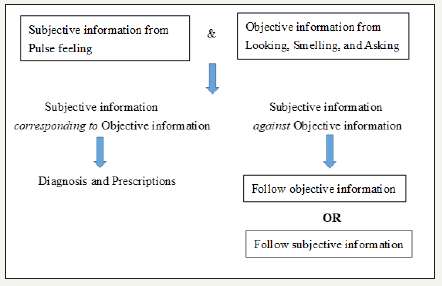- Submissions

Full Text
Advancements in Bioequivalence & Bioavailability
A View on Application of Artificial Intelligence in Pulse Feeling
Tong Zheng Hong*
Department of Health Sciences, Taiwan
*Corresponding author: Tong Zheng Hong, Department of Health Sciences, Taiwan
Submission: December 21, 2018;Published: February 12, 2019

ISSN 2640-9275 Volume2 Issue3
Abstract
Pulse feeling is one of the four skills as the information for diagnosis and treatment, which seems to be the most possible way for the application of artificial intelligence in terms of integrating traditional Chinese medicine with the Western medicine. However, such issues as the definition of the normal pulse, the use of automatic sphygmography for scientific evidence, the optimal decision-making method in the face of subjective and objective information deserve attention.
Keywords: Zeng (Pattern) Identification; Pulse feeling; Artificial intelligence; Automatic sphygmography
Introduction
Zeng (證, Pattern), which is based on the information gathered from the fours skills Looking, Smelling, Asking, and Pulse feeling, is the unique concept that distinguishes traditional Chinese medicine (TCM) and acupuncture from the Western medicine. Fundamental principles of signs and symptoms can reflect to some extent how internal organs function within the body, which is broader than in the Western medicine.
In clinic, screening the information gathered through the four skills is difficult for TCM physicians or acupuncturists because there will be three conditions: Pattern corresponding to Pulse, Pattern against Pulse, and selecting either Pattern or Pulse. In other words, TCM physicians or acupuncturists may face the challenges to pinpoint the key pattern for the best treatment outcomes. In the era of artificial intelligence (AI) progressing rapidly, it seems to be beneficial for the integration of AI with Pulse in saving time, costs and the best outcomes. However, there are issues for TCM physicians, acupuncturists, and researchers to consider for application of AI in the Pulse feeling skill.
Glance at AI and pulse feeling
AI is recognized as “a system’s ability to correctly interpret external data, to learn from such data, and to use those learnings to achieve specific goals and tasks through flexible adaptation” at present [1], which indicates that the data established for use is the key for applying AI to Pulse feeling. The pulse in the Western medicine is only viewed as a minor tool for diagnosis; however, Pulse diagnosis in TCM plays an important role for gathering information on
A. The balance in the body as a whole to get the whole picture of Qi, Blood, Yin-Yang, and even the constitution.
B. The functions of the specific organ.
Both TCM physicians and acupuncturists feel the pulse to discern width, amplitude, length, and particularly note the rate to differentiate the positions, the strength, and other qualities [2] which is different from observing the rhythm, intensity, rate, and whether any blood vessel tenderness, tortuosity, or nodularity in the Western medicine [3]. Information gathered from the Pulse diagnosis by the TCM physicians or acupuncturists can be complex and extremely subjective, even though there are in general 28 pulse qualities. Pulse in TCM bears the representations of Stomach qi, Spirit, and Root, which can be included in the data for diagnosis and treatment. However, it is truly difficult to define the normal pulse and interpreter properly Pulse without sufficient scientific evidence.
Challenging issues
The information obtained from the four diagnosis skills can be divided into objective and subjective. Pulse related information is viewed as subjective because it is abstract and judged by TCM physicians and acupuncturists, while objective information is gathered through Looking, Smelling, and Asking. Mai-jing (脈-經, Pulse Classic) is one of the TCM classics on Pulse published in the 3rd century. In this classic, Floating (or called Superficial) pulse is defined as the pulse is felt with light pressure but disappears with heavy pressure.
The first challenging issue is what the normal pulse really refers to. It is believed that the normal pulse can indicate the good state of Jing (Essence), Spirit, and Qi. However, the representations of Stomach qi, Spirit, and Root are abstract and obscure, though it is generally accepted that 4 beats per respiratory cycle means the presence of Stomach qi [4]. On the other hand, Spirit is said to be the combination of Jing (Essence) and Qi. Spirit refers to the strength in the Pulse felt soft. However, how soft it refers to remains unclear. To what degree the health and normal pulse is can arouse controversy from the aspect of the quantitative research. In other words, population and sampling are concerned in the scientific research. Unfortunately, the definition of the “normal pulse” seems to be the mission impossible.
The second challenging issue shows that all the descriptions of Pulse are indeed abstract to be interpreted accurately and challenge TCM physicians and acupuncturists. We can understand to some extent it is not easy at all to clarify how light or heavy this Pulse truly refers to, which can be only determined by the personal experience. The primary principle for TCM physicians and acupuncturists to follow in feeling the pulse is that they need to put fingers on the three pulse positions-Cun, Guan, and Chi at the radial artery of two hands simultaneously for the differentiation, feeling pulses presented in each position with light, median, or heavy pressures to make the differential diagnosis. This is the third issue that challenges those who follow scientific research methods to understand with automatic sphygmography [5,6].
As a matter of fact, what the specific pulse really refers to remains unreal and uncertain. The current automatic sphygmography cannot meet the clinical requirements because the real differences of pulse cannot be understood without light, median, or heavy pressures on each position on the two hands at the same time, which can surely makes the information incomplete for the differential diagnosis. The fourth challenge issue TCM physicians and acupuncturists face is how to select the information obtained from the four skills for diagnosis and treatment. In a whole, there are several options for TCM physicians and acupuncturists to make a proper decision in clinic shown in Figure 1.
Figure 1:Decision-making model in selective subjective and objective information.

Discussion
Zeng (Pattern) identification plays a key role in the diagnosis and treatment, which relies on the information gathered from the four skills. However, how to identify the correct Zeng indeed requires the experience of TCM physicians and acupuncturists. Pulse feeling is absolutely subjective and whether or not the pulses felt can really reflect the health condition can challenge TCM physicians and acupuncturists in making an accurate decision for diagnosis in clinic. It is for sure that the unexpected treatment outcomes may occur as long as TCM physicians and acupuncturists are not able to distinguish the minimal difference.
The real meaning of the “normal pulse” in TCM is confusing and makes it controversial to the scientific researchers. To some extent, this issue seems to be the first priority for the TCM physicians and acupuncturists to reconsider for the scientific research. With insufficient evidence gathered from the researches, whether or not the current automatic sphygmography developed with the scientific and technical methods can be used to detect the real pulses corresponding to the patient’s health state may be uncertain. In other words, the information provided by the automatic sphygmorgraphy may be not authentic enough to be included into the AI database.
Conclusion
The dialogue between TCM physicians and acupuncturists and the scientific researchers is required for the integration of TCM and the Western medicine. However, we need to understand that the language barriers may hinder TCM physicians and acupuncturists and scientific researchers from getting the real picture of TCM. In addition to Pulse feeling, the information obtained from the other three skills needs scientific evidence as well to link TCM physicians and acupuncturists with scientific researchers, which deserves much more attention.
References
- Andreas K, Haenlein M (2018) Siri, Siri in my hand, who’s the fairest in the land? on the interpretations, illustrations and implications of artificial intelligence. Business Horizons 62(1).
- Sacred lotus Chinese medicine TCM diagnosis by palpation (pulse diagnosis)-one of the 4 pillars.
- Hal HA Misguided study to test the reliability of traditional medicine pule.
- Maciocia G (1994) The practice of Chinese medicine: The treatment of diseases with acupuncture and Chinese herbs. Churchill Livingstone
- Hsiao TC (2009) Multi-channel signal processing technology for the modification of automatic sphygmography. yearbook of Chinese medicine and phamacy. Ministry of Health Department, Taipei, Taiwan.
- Liu SH (2009) A Portable automatic sphygmography and pattern recognition of pulse waveform. yearbook of Chinese medicine and phamacy. Ministry of Health Department, Taipei, Taiwan.
© 2018 Tong Zheng Hong. This is an open access article distributed under the terms of the Creative Commons Attribution License , which permits unrestricted use, distribution, and build upon your work non-commercially.
 a Creative Commons Attribution 4.0 International License. Based on a work at www.crimsonpublishers.com.
Best viewed in
a Creative Commons Attribution 4.0 International License. Based on a work at www.crimsonpublishers.com.
Best viewed in 







.jpg)






























 Editorial Board Registrations
Editorial Board Registrations Submit your Article
Submit your Article Refer a Friend
Refer a Friend Advertise With Us
Advertise With Us
.jpg)






.jpg)














.bmp)
.jpg)
.png)
.jpg)










.jpg)






.png)

.png)



.png)






